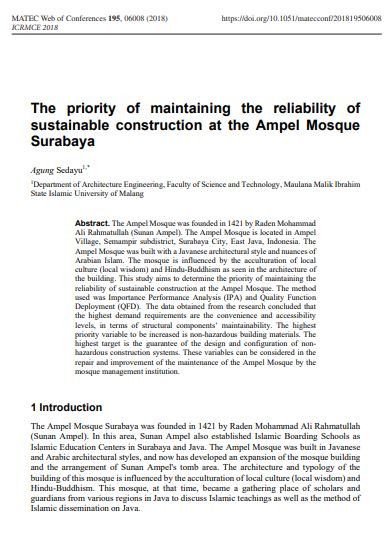
The Ampel Mosque was founded in 1421 by Raden Mohammad Ali Rahmatullah (Sunan Ampel). The Ampel Mosque is located in Ampel Village, Semampir subdistrict, Surabaya City, East Java, Indonesia. The Ampel Mosque was built with a Javanese architectural style and nuances of Arabian Islam. The mosque is influenced by the acculturation of local culture (local wisdom) and Hindu-Buddhism as seen in the architecture of the building. This study aims to determine the priority of maintaining the reliability of sustainable construction at the Ampel Mosque. The method used was Importance Performance Analysis (IPA) and Quality Function Deployment (QFD). The data obtained from the research concluded that the highest demand requirements are the convenience and accessibility levels, in terms of structural components’ maintainability. The highest priority variable to be increased is non-hazardous building materials. The highest target is the guarantee of the design and configuration of non-hazardous construction systems. These variables can be considered in the repair and improvement of the maintenance of the Ampel Mosque by the mosque management institution.
Sedayu, Agung. “The priority of maintaining the reliability of sustainable construction at the Ampel Mosque Surabaya.” In MATEC Web of Conferences, vol. 195, p. 06008. EDP Sciences, 2018.
I agree to the terms outlined below:
You agree to upload and assign Mosqpedia Database the rights to use the content worldwide and in perpetuity across all current and future media platforms. Mosqpedia Database may edit, copy, adapt and translate your contribution.
The content will be distributed under the Creative Commons Attribution-Deed – Attribution-NonCommercial-NoDerivatives 4.0 International – Creative Commons
All data will be stored in line with data protection regulations.